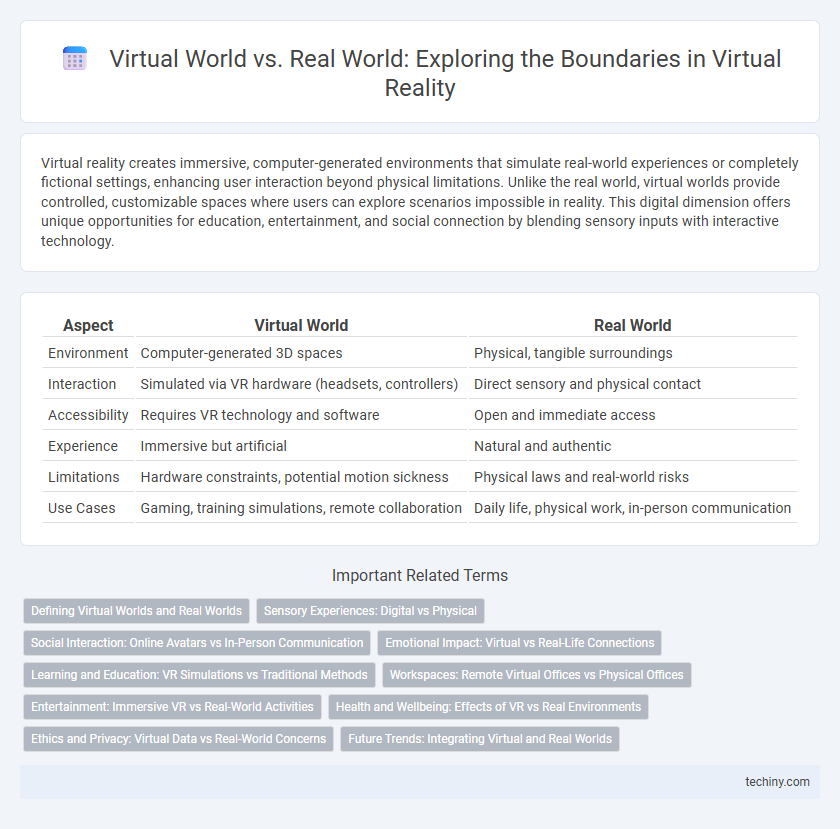Virtual reality creates immersive, computer-generated environments that simulate real-world experiences or completely fictional settings, enhancing user interaction beyond physical limitations. Unlike the real world, virtual worlds provide controlled, customizable spaces where users can explore scenarios impossible in reality. This digital dimension offers unique opportunities for education, entertainment, and social connection by blending sensory inputs with interactive technology.
Table of Comparison
| Aspect | Virtual World | Real World |
|---|---|---|
| Environment | Computer-generated 3D spaces | Physical, tangible surroundings |
| Interaction | Simulated via VR hardware (headsets, controllers) | Direct sensory and physical contact |
| Accessibility | Requires VR technology and software | Open and immediate access |
| Experience | Immersive but artificial | Natural and authentic |
| Limitations | Hardware constraints, potential motion sickness | Physical laws and real-world risks |
| Use Cases | Gaming, training simulations, remote collaboration | Daily life, physical work, in-person communication |
Defining Virtual Worlds and Real Worlds
Virtual worlds are computer-generated environments that simulate real or imagined settings, enabling users to interact through avatars and immersive technologies like VR headsets. Real worlds consist of the physical, tangible environments and experiences occurring naturally, perceived through human senses. The differentiation lies in virtual worlds' reliance on digital construction and interactivity, while real worlds are grounded in actual physical existence.
Sensory Experiences: Digital vs Physical
Virtual Reality creates immersive sensory experiences by simulating sight, sound, and touch, allowing users to interact with digital environments that can mimic or surpass real-world stimuli. In contrast, the real world offers rich, multi-sensory input grounded in physical presence, including temperature, scent, and tactile feedback that remain challenging to replicate digitally. Advancements in haptic technology and spatial audio aim to narrow the gap between virtual and physical sensory experiences, enhancing realism and user engagement.
Social Interaction: Online Avatars vs In-Person Communication
Virtual worlds facilitate social interaction through customizable online avatars, allowing users to express identity beyond physical limitations and connect globally in real time. In-person communication offers rich nonverbal cues, such as facial expressions and body language, fostering deeper emotional understanding and trust. While virtual interactions expand social reach and inclusivity, real-world engagements provide unmatched authenticity and nuanced interpersonal connection.
Emotional Impact: Virtual vs Real-Life Connections
Virtual worlds offer immersive experiences that can evoke strong emotional responses through interactive environments and avatars, yet they often lack the depth of sensory and spontaneous nuances found in real-life connections. Real-world interactions engage multiple senses and nonverbal cues, fostering deeper emotional bonds and empathy that virtual experiences struggle to replicate fully. Emotional impact in virtual realities depends heavily on technology quality and user engagement, while real-life connections remain unmatched in authenticity and emotional resonance.
Learning and Education: VR Simulations vs Traditional Methods
Virtual Reality simulations provide immersive, interactive learning environments that enhance retention and understanding by enabling students to visualize complex concepts and practice skills in realistic scenarios. Traditional methods rely heavily on textbooks and lectures, which often lack engagement and limit experiential learning opportunities. VR's ability to simulate real-world situations fosters deeper comprehension and critical thinking, making it a powerful tool for education and professional training.
Workspaces: Remote Virtual Offices vs Physical Offices
Remote virtual offices in virtual reality offer immersive collaboration environments with interactive 3D workspaces that enhance team engagement beyond flat video calls. Physical offices provide tangible social interactions and spontaneous communication, but virtual workspaces reduce commuting time and enable global workforce integration with customizable layouts. Companies adopting VR for remote work report increased productivity and employee satisfaction by combining flexibility with virtual presence.
Entertainment: Immersive VR vs Real-World Activities
Immersive VR offers entertainment experiences that transcend physical limitations, enabling users to explore fantasy environments, interact with dynamic virtual elements, and participate in interactive storytelling that real-world activities cannot replicate. Real-world activities provide tangible social interactions, physical sensations, and spontaneous unpredictability that enhance emotional connection and authenticity. The balance between VR entertainment and real-world engagement depends on personal preference, with VR excelling in immersive visual stimulation and real-life fostering multisensory and interpersonal dynamics.
Health and Wellbeing: Effects of VR vs Real Environments
Virtual reality environments can enhance mental health by providing immersive experiences that reduce stress and anxiety through controlled sensory stimuli, fostering relaxation and mindfulness. In contrast, real-world environments offer natural sensory inputs such as fresh air, sunlight, and physical social interactions, which are essential for physical well-being and immune system support. Research indicates that prolonged exposure to VR may lead to eye strain and disorientation, whereas real-world exposure promotes physical activity and vitamin D synthesis, highlighting the need for balanced interaction between both environments.
Ethics and Privacy: Virtual Data vs Real-World Concerns
Virtual worlds generate vast amounts of personal data, raising complex ethical questions about ownership, consent, and surveillance that surpass traditional privacy concerns in the real world. Unlike real-world interactions, virtual environments often lack clear regulatory frameworks, making data protection and user anonymity critical challenges. Ethical considerations must address how virtual data is collected, stored, and used to prevent potential misuse and safeguard user rights.
Future Trends: Integrating Virtual and Real Worlds
Future trends in virtual reality emphasize seamless integration of virtual worlds with the real world, enhancing immersive experiences through mixed reality technologies. Advances in augmented reality (AR) and extended reality (XR) enable real-time interaction between digital content and physical environments, transforming industries such as education, healthcare, and entertainment. The convergence of AI-driven virtual environments with real-world data promises personalized, context-aware applications that blur the boundaries between reality and virtual immersion.
Virtual world vs Real world Infographic

 techiny.com
techiny.com